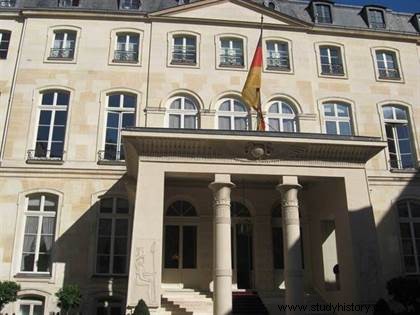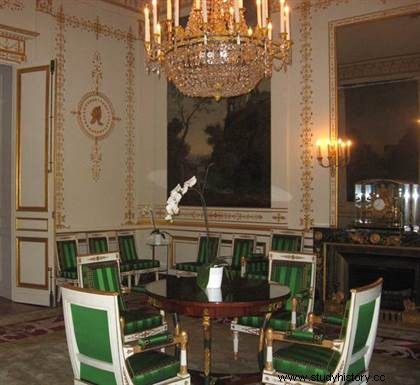 Private estate and symbol of the Empire style, Hôtel de Beauharnais, located rue de Lille in the 7th arrondissement of Paris is the current residence of the German Ambassador to France. On the occasion of a private visit, Histoire pour tous, retraces all in image, the history of the magnificent hotel and the various owners including the famous Eugène de Beauharnais, one of the most faithful officers of Napoleon Bonaparte .
Private estate and symbol of the Empire style, Hôtel de Beauharnais, located rue de Lille in the 7th arrondissement of Paris is the current residence of the German Ambassador to France. On the occasion of a private visit, Histoire pour tous, retraces all in image, the history of the magnificent hotel and the various owners including the famous Eugène de Beauharnais, one of the most faithful officers of Napoleon Bonaparte .
Hôtel de Beauharnais:why is it called that?
The hotel takes its name from Prince Eugène de Beauharnais who was 22 years old when he bought it in 1803 to undertake further work. He is the third owner of the hotel after Jean-Baptiste Colbert, the nephew of the great minister of Louis XIV and the Duke of Villeroy. He was a punctual resident after his campaigns during these brief returns to Paris. Noting the high amount of renovation costs, Napoleon withdrew the right to use it and made the hotel an official residence for guests.
 Eugène de Beauharnais (1781-1824) is the step son of Napoleon because he is the child of Joséphine and Alexandre de Beauharnais. He began his career in 1797 as Napoleon's aide-de-camp during the Italian campaign and then in Egypt. After the establishment of the Empire in 1804, he became Viceroy of Italy and married in January 1806 the daughter of the King of Bavaria. Until the birth of the King of Rome in 1811, Eugène de Beauharnais was Napoleon's heir apparent. It is good to remember that the King of Rome is the son of Napoleon and Archduchess Marie-Louise of Austria.
Eugène de Beauharnais (1781-1824) is the step son of Napoleon because he is the child of Joséphine and Alexandre de Beauharnais. He began his career in 1797 as Napoleon's aide-de-camp during the Italian campaign and then in Egypt. After the establishment of the Empire in 1804, he became Viceroy of Italy and married in January 1806 the daughter of the King of Bavaria. Until the birth of the King of Rome in 1811, Eugène de Beauharnais was Napoleon's heir apparent. It is good to remember that the King of Rome is the son of Napoleon and Archduchess Marie-Louise of Austria.
The history of the hotel and its first owners
 The Hôtel de Beauharnais was built on the left bank of the Seine by the architect Germain Boffrand in 1713. It was sold in 1715 to Jean-Baptiste Colbert, Marquis de Torcy then to the Duke of Villeroy around 1766. After its acquisition in 1803, Prince Eugène de Beauharnais had work carried out, particularly on the facade of the hotel.
The Hôtel de Beauharnais was built on the left bank of the Seine by the architect Germain Boffrand in 1713. It was sold in 1715 to Jean-Baptiste Colbert, Marquis de Torcy then to the Duke of Villeroy around 1766. After its acquisition in 1803, Prince Eugène de Beauharnais had work carried out, particularly on the facade of the hotel.
It is possible to see neo-Egyptian porticoes, works of the architect Jean Augustin Renard. These porticoes bear witness to the enthusiasm of the time for Egyptian fashion, which can be explained by Napoleon's campaign (1798-1799). Napoleon was accompanied by 167 scholars during the expedition to Egypt and returned with the Rosetta Stone.
On February 6, 1818, the hotel became the property of Prussia and Frederic William II of Prussia for 570,000 francs. who restored it. Several personalities stayed at the hotel, such as Bismarck, the composer Richard Wagner or the mother of William II. It was in 1871 with the birth of the German Empire that the hotel became the seat of its embassy. It was taken over by the French state at the end of the Second World War and returned in 1961. The Hôtel de Beauharnais has been listed as a historical monument since July 25, 1951 .
The Empire style:a sumptuous interior
The Empire style is defined by massive and imposing furniture and by a predominance of mahogany furniture decorated with bronze. The imitation of antiquity is another characteristic, the chiseled bronze ornaments are inspired by the Greek-Roman or Egyptian style. The most significant artists are Charles Percier and Pierre-François-Léonard Fontaine because they are considered the creators of this style. The Hôtel de Beauharnais is a beautifully restored symbol of the Empire style. You should know that the residence contains most of the original furniture from Eugene's time.
 When you enter through the Egyptian porticoes, the Hôtel de Beauharnais reveals on the ground floor, a magnificent library, the work of cabinetmaker Jacob Desmalter, as well as on the left, the green living room with landscapes by Hubert Robert and a green marble fireplace. A little further on is the dining room with Mamluk paintings.
When you enter through the Egyptian porticoes, the Hôtel de Beauharnais reveals on the ground floor, a magnificent library, the work of cabinetmaker Jacob Desmalter, as well as on the left, the green living room with landscapes by Hubert Robert and a green marble fireplace. A little further on is the dining room with Mamluk paintings.
It is after climbing the main staircase that you can see, on the first floor, the throne room, the pink room or the four seasons room. in Pompeian style representative of the muses. Napoleonic symbols are present through the figure of the eagle and the bees. On the same floor are the apartments of Queen Hortense , Queen of Holland and sister of Eugène de Beauharnais. The apartments consist of a magnificent bedroom containing the state bed, a music room, an oriental boudoir and a marble bathroom.
Practical information
Hotel de Beauharnais:78, rue de Lille 75007 Paris, France
Historic monument since July 25, 1951
Access on demand
- German Embassy website
